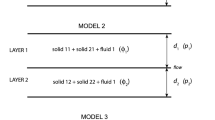Abstract
Stability of precariously balanced rocks is employed in seismic hazard estimates. Standard toppling models of these rocks are based on a rigid body motion, i.e., this approximation assumes that their eigenfrequencies are infinite in any position of a rock. This assumption is, however, questionable in the case of rocking stones oscillating with lowest eigenfrequencies of only several hertz when resonance effects facilitating rolling/wobbling due to a seismic signal cannot be a priori excluded. An example demonstrating existence of such low frequencies is “the Hus Pulpit” rocking stone located in the Central Bohemian Pluton (49.568N,14.363E). The observed lowest frequencies recorded by a Guralp CMG-40T seismometer located on the top of this rocking stone are 3, 7 and 9 Hz with the quality factors of 60, 55 and 77, respectively. Using the COMSOL Multiphysics software package we model the oscillations of this rocking stone numerically and demonstrate that these observed low frequencies and their dampings can be explained by a force interaction between the stone base and the bedrock that can formally be interpreted as the damped elastic response of the bedrock to its surface deformation by the stone. We also numerically study stability of the stone under the presence of such an interaction and conclude that beginning of toppling requires very high horizontal PGV (PGA) for input seismic frequencies even at the resonance frequencies. However, different numerical models, where the seismic displacements are considered as the direct input at the rock base, can result in rock instabilities under a presence of an \(\hbox {M}=7\) earthquake at a distance of about 150 km.









Similar content being viewed by others
References
Anderson, J. G., & Brune, J. N. (1999). Methodology for using precarious rocks in Nevada to test seismic hazard models. Bulletin of the Seismological Society of America, 89(2), 456–467.
Anooshehpoor, A., Brune, J. N., & Zeng, Y. (2004). Methodology for obtaining constraints on ground motion from precariously balanced rocks. Bulletin of the Seismological Society of America, 94, 285–303.
Anooshehpoor, A., Brune, J. N., Daemen, J., & Purvance, M. D. (2013). Constraints on ground accelerations inferred from unfractured hoodoos near the Garlock fault, California. Bulletin of the Seismological Society of America, 103, 99–106.
Apostolou, M., Gazetas, G., & Garini, E. (2007). Seismic response of slender rigid structures with foundation uplifting. Soil Dynamics and Earthquake Engineering, 27, 642–654.
Becker, A., Davenport, C. A., Eichenberger, U., Gilli, E., Jeannin, P.-Y., & Lacave, C. (2006). Speleoseismology: A critical perspective. The Journal of Seismology, 10, 371–388. https://doi.org/10.1007/s10950-006-9017-z.
Boore, D. M., Stewart, J. P., Seyhan, E., & Atkinson, G. M. (2014). NGA-West2 equations for predicting PGA, PGV, and 5%-damped PSA from shallow crustal earthquakes. Earthquake Spectra, 30, 1057–1085.
Brune, J. N., Anooshehpoor, A., Purvance, M. D., & Brune, R. J. N. (2006). Band of precariously balanced rocks between the Elsinore and San Jacinto, California, fault zones: Constraints on ground motion for large earthquakes. Geology, 34, 137–140. https://doi.org/10.1130/G22127.1.
Domokos, G., Sipos, A., & Szabo, T. (2012). The mechanics of rocking stones: Equilibria on separated scales. Mathematical Geosciences, 44, 71–89. https://doi.org/10.1007/s11004-011-9378-x.
Gribovszki, K., Kovács, K., Mónus, P., Bokelmann, G., Konečný, P., Lednická, M., et al. (2017). Estimating the upper limit of prehistoric peak ground acceleration using in situ, intact and vulnerable stalagmite from Plavecká priepast cave (Detreköi-zsomboly). Little Carpathians, Slovakia–first result. The Journal of Seismology, 21, 1111–1130. https://doi.org/10.1007/s10950-017-9655-3.
Gribovszki, K., Esterhazy, S., & Bokelmann, G. (2018). Numerical modeling of stalagmite vibrations. Pure and Applied Geophysics, 175, 4501–4514. https://doi.org/10.1007/s00024-018-1952-4.
Hall, D. B. (1996). Modelling failure of natural rock columns. Geomorphology, 15, 123–134.
Housner, G. W. (1963). The behavior of inverted pendulum structures during earthquakes. Bulletin of the Seismological Society of America, 53, 403–417.
Lacave, C., Koller, M. G., & Egozcue, J. J. (2004). What can be concluded about seismic history from broken and unbroken speleothems? The Journal of Earthquake Engineerin, 8, 431–455.
Menon, A., Lai, G., & Macchi, G. (2004). Seismic hazard assesment of the historical site of Jam in Afganistan and stability analysis of the minaret. The Journal of Earthquake Engineerin, 8, 251–294.
Purvance, M. D., Brune, J. N., Abrahamson, A., & Anderson, J. G. (2008). Consistency of precariously balanced rocks with probabilistic seismic hazard estimates in southern California. Bulletin of the Seismological Society of America, 98, 2629–2640.
Schürch, P., & Becker, A. (2005). Studies on ’precarious rocks’ in the epicentral area of the AD 1356 Basle earthquake, Switzerland. Geophysical Journal International, 163, 689–697.
Shi, B., Anooshehpoor, A., Zeng, Y., & Brune, J. N. (1996). Rocking and overturning of precariously balanced rocks by earthquakes. Bulletin of the Seismological Society of America, 86, 1364–1371.
Stewart, J. P., Boore, D. M., Seyhan, E., & Atkinson, G. M. (2016). NGA-West2 equations for predicting vertical-component PGA, PGV, and 5%-damped PSA from shallow crustal earthquakes. Earthquake Spectra, 32, 1005–1031.
Veeraraghavan, S., Hudnut, K. W., & Krishnan, S. (2017). Toppling analysis of the Echo Cliffs precariously balanced rock. Bulletin of the Seismological Society of America, 107, 72–84. https://doi.org/10.1785/0120160169.
Verruijt, A. (2010). An introduction to soil dynamics. New York: Springer. ISBN:10:9048134404.
Weichert, D. (1994). Omak rock and the 1872 Pacific Northwest earthquake. Bulletin of the Seismological Society of America, 84, 444–450.
Acknowledgements
We thank Ladislav Hanyk for his comments, Miroslav Coubal for technical help, Rasool Anooshehpoor and an anonymous reviewer for the helpful and constructive reviews. This research was supported by the program “Support of Perspective Human Resources – Postdoctoral Research at the Institutes of the Czech Academy of Sciences“ and the project “Strategy AV21 - Natural Hazards” funded by the Czech Academy of Sciences.
Author information
Authors and Affiliations
Corresponding author
Additional information
Publisher's Note
Springer Nature remains neutral with regard to jurisdictional claims in published maps and institutional affiliations.
Rights and permissions
About this article
Cite this article
Zábranová, E., Matyska, C., Stemberk, J. et al. Eigenoscillations and Stability of Rocking Stones: The Case Study of “The Hus Pulpit” in The Central Bohemian Pluton. Pure Appl. Geophys. 177, 1907–1916 (2020). https://doi.org/10.1007/s00024-019-02296-z
Received:
Revised:
Accepted:
Published:
Issue Date:
DOI: https://doi.org/10.1007/s00024-019-02296-z




